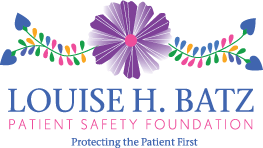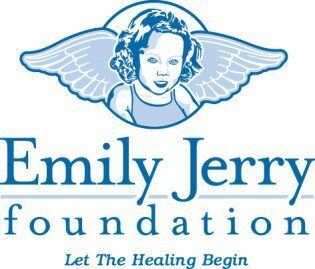This week is National Patient Safety Awareness Week. See my thoughts on this from 2012. Every week should be National Patient Safety IMPROVEMENT Week, as the problem is that dire. But, it's great to try to bring to light the risks of our modern healthcare system in the U.S. and other countries.
I often point out the organizational culture problems that lead to bad systems and bad processes (this is not a “bad people” problem). There are many great people working hard in healthcare every day.
But, I'd like to highlight some of the amazing people who are really working to make a difference in improving our broken system.
Louise H. Batz Patient Safety Foundation

The Batz Foundation was started by a woman, Laura Townsend, who grew up right near where I now live in San Antonio. Her mother, Louise Batz, died tragically after a medication error that occurred during her hospitalization after a knee-replacement surgery. Read her story.
Like others in the patient safety community, Laura and her family had the amazing strength to channel their energy into helping improve the system to prevent problems for others. I realize admire that people like Laura can focus on the future instead of being angry about the past.
They have produced a fantastic guide for patients and families, The Batz Guide For Bedside Advocacy. You can get this as a free PDF (in English or Spanish), a physical book, or as an iPad app.
It's a guide I would recommend to my own family and friends. The guide prompts patients to track important information about their health and care, before, during, and after a hospitalization. The guide also recommends important questions to ask about your own care and safety.
I gave a copy of the guide to a friend who recently had surgery. She used the book a lot before her procedure and here was her comment part-way through her recovery:
“I loved the workbook you gave me. It's AMAZING how much I had to manage my healthcare under the influence of narcotics.”
That's not right. We need to improve the system so patients don't have to do that and so that the Batz Guide isn't necessary. But, today, I'm glad it is.
I'm also honored to be on the Batz Foundation's board and I'm happy to volunteer with them.
Read the article that appeared in last Friday's special USA Today supplement on patient safety (PDF). You can also read most of the series online.
The Emily Jerry Foundation
In 2006, young Emily Jerry died as the result of a preventable chemotherapy medication error at an Ohio hospital.
The pharmacist, Eric Cropp, who was the supervising pharmacist at the time was convicted and jailed, something that I think is a travesty (as I blogged about in 2010). Who else agrees that blaming the pharmacist does nothing to protect future patients? Emily's father, Christopher Jerry.
Chris started the Emily Jerry Foundation as a way of helping others by preventing future medical errors. Chris has often shared a stage with the pharmacist to talk about what healthcare needs to do to improve safety.
I have talked with Chris before and we managed to cross paths recently in Orlando, where I was attending the Society for Health Systems conference and Chris was speaking at a HIMSS event.
Why did Emily die?
Because she was given a saline solution that was erroneously too high in concentration.
Why did this occur?
The pharmacy technician mixed the solution instead of using a pre-made bag.
Why didn't the pharmacy tech use a pre-mixed bag?
Because there was a supply shortage and the hospital didn't have them. Note, this is still a problem today. Salt water bags??? A shortage? Good grief.
There were other contributing factors in the case. The technician was surfing the web planning her wedding. The pharmacist says they were slammed and overworked. The pharmacist didn't catch the error. The technicians claims she tried to speak up but was brushed off.
What hospital CEO or supply chain VP has ever gone to jail due to a supply shortage? What pharmacy director has ever been jailed for having bad processes or an overworked department? None that I'm aware of.
I don't think the answer is jailing MORE people. The answer is fixing processes, systems, and culture. I'm glad Chris Jerry is leading this charge. As he said in his talk:
“Where did the systems break down? Where did the processes fail Emily, a beautiful little girl?… I believe we can get to zero deaths from preventable errors because they are that preventable.”
He blames systems, not individuals.
Read their article that appeared in last Friday's special USA Today supplement on patient safety (PDF).
Chris has agreed to be a podcast guest in the near future.
The Josie King Foundation
There's also, of course, Sorrel King, the founder of the Josie King Foundation. Sorrel was my guest for episode #78 of my podcast series.
Like Laura and Chris, Sorrel was able to channel her energy into working with Johns Hopkins and others to improve patient safety.
As you can read about here, Josie died at Johns Hopkins after a number of factors, including nurses and physicians not listening to Sorrel's concerns that something was wrong with her little girl.
I hope we can all do something to help support the important mission that these three foundations all share.
Please scroll down (or click) to post a comment. Connect with me on LinkedIn.
Let’s work together to build a culture of continuous improvement and psychological safety. If you're a leader looking to create lasting change—not just projects—I help organizations:
- Engage people at all levels in sustainable improvement
- Shift from fear of mistakes to learning from them
- Apply Lean thinking in practical, people-centered ways
Interested in coaching or a keynote talk? Let’s start a conversation.












I clinically applaud all the above in the quest to improve patient safety and reduce all various known harms to patients. We often don’t acknowledge the Power of One but we really have to as that “one” is the stepping stone to gaining support for the betterment of all. Increasing others involvement in engaging in this noble safety quest should be constant and demonstrate the perseverance necessary to make significant change for the positive. I make it a point to do this daily in all aspects of patient care and the quality they so richly deserve. Congratulations to all those acknowledge and do not waiver for one moment. Safety is silent, harm is noisy we need to do our part to make it the silent safety of healthcare and best practice endorsement..
Lynn Razzano RN,MSN,ONCC Clinical Nurse Consultant PPAHS
Hi Lynn – can you explain what you mean by the “Power of One”?
Thanks for asking. The Power Of One was a annual conference them that Covidien had one year that I was working as a clinical nurse consultant. The key note speaker was the Navy Seal Officer that was the only survivor in the group of 4 Navy Seals. He authored the book ” he Lone Survivor” which this year became a movie. The name of Navy Seal officer who was the Lone Survivor is: Marcus Luttrell. It is the eyewitness account of Operation Redwing and the lost of heroes of Seal Team 10. If you ever have a chance to read, please do so. To hear him in person is compelling and you never forget what he had to say as well as live with daily.
The Power of one is the person who speaks out against all odds and makes a positive impact to truly making a difference in other peoples’s lives. I have not doubt you have done this on many an occasion and even writing this acknowledgment article on the faces of those that have made a huge contribution to safer health care and elimination of harm.
In re reading what I wrote he may have looked to be a spiritual statement but it truly is an empowering one for those that step up,make their voices known despite people not supporting you. I as a long time nurse have experienced this many a time but persevered and did make a difference in the lives of others. I now write in my professional publications about prevention of VTE in pregnant women and stoke patients, as well as advocating for the use of continuous electronic monitoring when opioids are used on patients.
I hope you are having a great week end. I look forward to reading other articles you continue to write.
Very Best Regards
Lynn
I hope this explains this and you continue to be impactful and be a powered of one in your own right.
There are 440,000 people dying in our country from preventable medical errors. These do not include the figures which are hidden or the gray figures that never made it as part of the statistics. Depending on what article you read, the figures could be anywhere between 750,000 and 1,000,000. This is genocide. Why? Our government is so corrupt they refuse to acknowledge this is happening and are ignoring it. The difference between genocide in the United States and elsewhere is, nobody is singled out. Babies, children, young, old, black, white, all are dying across the board.
Our country passed laws preventing Americans from getting justice and accountability. Americans can not even have the right of due process under our 7th Amendment Constitutional Right. Yet, we preach to the world about “rights” under the guise of respectability. The fact is, we are corrupt and have lost our humanity years ago. We sold our soul to the company store.
http://youtu.be/aEOlpahRtnQ
Sending you a link to show you the best medical care given in our country could possibly be the veterinarian clinics. Maybe the most merciful way to end a patient’s suffering would be pulling the trigger. You judge.
If you find yourself in Texas, make sure your life insurance policy is paid in full.
If you are in NYC, avoid the doctor mentioned. The Texas Medical Board failed to police after their own.
Thank you for your time,
Cilla Mitchell
A Texas nurse and US Army vet.
If link provided does not work, Google: Dr. Javier Andrade, why did you kill Cleveland Mark Mitchell? – youtube.
He is working at the New York Bariatric Group and they know he killed my husband but have chosen to overlook this minor technicality.
Cilla-
I’m very sorry for the loss of your husband. I cannot imagine the pain and grief that you must be experiencing.
There’s no excuse for a patient to be ignored in the waiting room for 17.5 hours. Sadly, this happens in hospitals throughout the country.
When we ask “why?”, the answers are far more complex than a single “bad doctor.” There’s a system that the doctor works in, including nurses and administrators.
Why was there such a long wait? Why was the emergency department overwhelmed? Why does a patient fall through the cracks. It’s probably more complicated than it being a single doctor’s fault.
See the case of Brian Sinclair from Winnipeg, Canada:
I wrote about this more here in this blog post.
Then there was the case of Michael Herrara in Dallas.
It’s usually not a doctor’s fault. These are very systemic problems that require more systemic solutions.
Again, I’m sorry for your loss… no amount of problem solving or improvement work does anything to bring your husband back, I realize that. But the organizations I featured in this blog post are trying to help save others.
P.S. I am not a fan of so-called “tort reform.” The best tort reform is preventing the need for lawsuits to begin with by protecting patients and their loved ones.
Mark,
I appreciate the words and you are a very good man. You are making a difference and it is more than most. However, during Andrade’s initial assessment of my husband, knowing he was a 7 day post abdominal hernia repair and was admitted in the ER for acute abdominal pain, he failed to order, labs, X-rays, or IV’s to hydrate him. He failed to administer the basic standard of care, and therefore dropped the ball. The emergency room was not busy that night. It wasn’t like there was a lot of emergencies going on. It was relatively quiet. He needed to be held accountable, and wasn’t. No excuses.
Sure, when the systems improvement, Lean, and patient safety communities say, basically, that 90+% of problems are “due to the system,” there’s a reason nobody says 100% of problems are systemic. Sometimes, it does trace back to an individual and what they did (or didn’t do).
I agree with your last sentence. I also believe if the medical boards policed after their own and upheld their mission statements, over 50% of preventable medical errors would be eliminated.
Thank you for responding to my post,
Cilla Mitchell